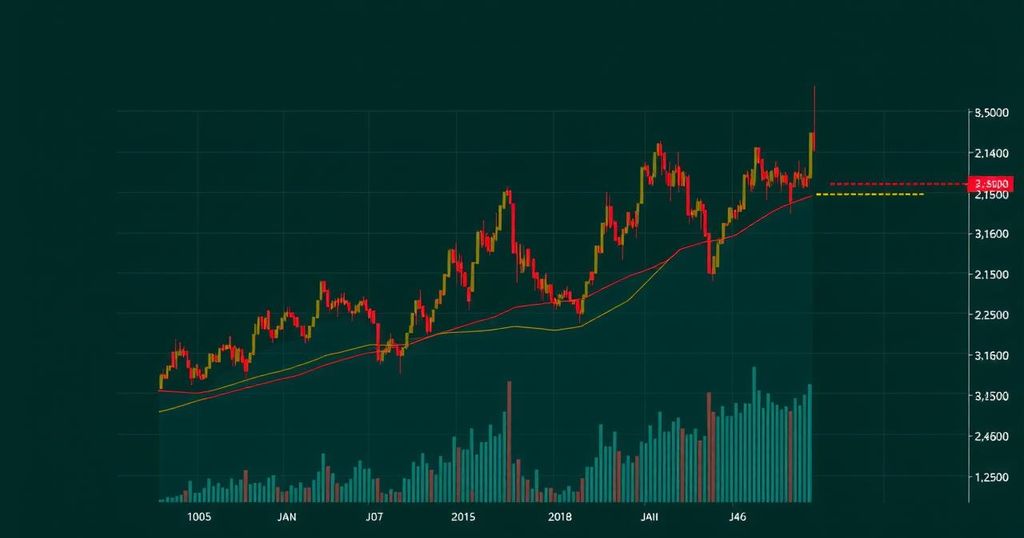Three Reasons Why Bitcoin Price Struggles at the $90,000 Resistance Level
Bitcoin struggles to surpass the $90,000 resistance level due to constant selling pressure from short-term holders, tightening liquidity conditions, and declining demand from new investors. These elements hinder market potential for a rally despite a substantial portion of wealth held by long-term holders.
Bitcoin’s recent price performance indicates an inability to surpass the $90,000 resistance level, particularly following a peak of $88,752 on March 24. As the week concludes, Bitcoin has failed to reclaim the $88,000 threshold, diminishing its chances of testing the $90,000 mark before the quarter ends.
One significant factor contributing to Bitcoin’s current pricing predicament is persistent sell-side pressure from short-term holders, defined as those possessing their Bitcoin for less than 155 days. According to Glassnode’s “The Week On-chain” newsletter, the present cycle has become increasingly “top-heavy,” with buyers at higher price points dominating Bitcoin’s supply. Consequently, these short-term holders are experiencing substantial price losses since Bitcoin’s notable 30% correction.
Analysts at Glassnode reported, “Volume of Short-Term Holder supply held in loss surging to a massive 3.4M BTC. This is the largest volume of STH supply in loss since July 2018.” This selling trend is evident in Bitcoin’s accumulation trend score, which has remained below 0.1 following a decline from $108,000 to the $93,000-$97,000 range. A score under 0.5 indicates distribution rather than accumulation, while a sub-0.1 score indicates strong selling pressure.
Moreover, Bitcoin’s struggle to break past the $90,000 barrier is compounded by tightening liquidity conditions. Recent data illustrates a 47% decrease in on-chain transfer volumes, which have fallen to $5.2 billion daily from previous highs. Additionally, the active address count has dropped by 18%, falling to 780,000 from November’s peak of 950,000.
Further evidence of this trend includes a 24% decline in open interest within the Bitcoin futures market, decreasing from $71.85 billion to $54.65 billion. The reduction in perpetual futures funding rates has also cooled market activity. This deleveraging, alongside only 2.5% of the overall supply remaining profitable during market corrections, exposes a lack of sufficient buy orders needed to counter sell orders.
Additionally, demand for Bitcoin is in decline. Glassnode data indicates that the current bull cycle lacks new market entrants, with the Cost Basis Distribution (CBD) Heatmap showing significant supply concentration at elevated price levels (between $100K and $108K), yet insufficient buyer activity at lower levels to trigger a price rebound.
This situation is further exacerbated by prevailing macroeconomic uncertainty, which has deterred prospective investors as illustrated by a transition to net capital outflows. This trend is particularly evident when the 1-week to 1-month short-term holder cost basis falls below that of the 1-month to 3-month cohort.
However, analysts from Glassnode note that, “The flip side of these observations is that the Long-Term Holder cohort still retains a substantial portion of the network wealth, holding almost 40% of invested value.” In essence, periods of extensive accumulation can eventually restrict supply and foster conditions conducive to renewed demand once a sustained upward market trend is established.
In summary, Bitcoin’s inability to breach the significant $90,000 resistance level is primarily influenced by persistent selling pressure from short-term holders, a contraction in liquidity, and declining new demand due to macroeconomic uncertainties. Furthermore, while the current market lacks new buyers, long-term holders maintain a significant portion of Bitcoin’s total wealth, which may facilitate future stability and demand should the market dynamics improve.
Original Source: cointelegraph.com








Post Comment